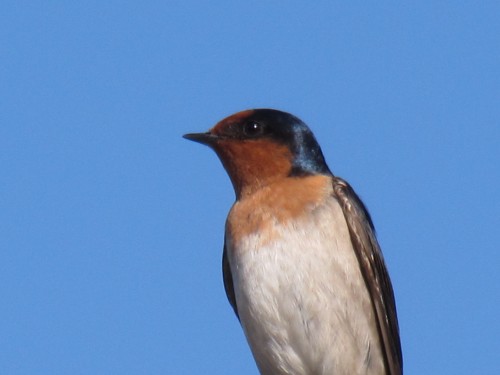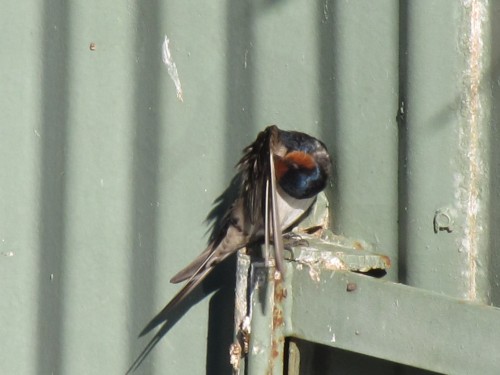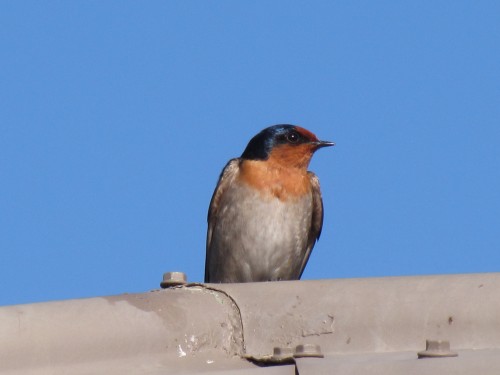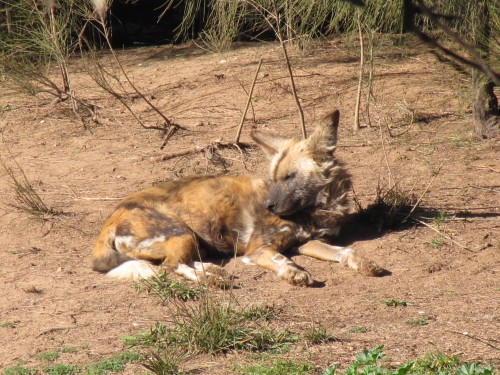Welcome Swallows everywhere
In our extensive travels in South Australia, Victoria and New South Wales in recent years I have often observed Welcome Swallows. They are a widespread and very common species throughout their range in eastern, southern and parts of western Australia. In recent months I have often seen a dozen or more flying above our garden, indeed, more often than in many previous years.
Not often, however, have I had the opportunity to photograph them up close. They don’t sit still very often, preferring to keep flying and feeding on any flying insects there might be around. More than once I have hoped for a pair to set up home under our veranda where it would be easier to get photos. They had different ideas, of course.
It was with delight then, during our visit to the Western Plains Zoo in Dubbo a few weeks ago, that one of many swallows flying around decided to settle for a few moments on the edge of the African Wild Dog enclosure. Just a few metres from me. Well within easy camera range. Too easy.
After a few minutes it flew off and another one came in to rest, this time a little lower on the fence. This one decided that the early morning sunshine on such a cold morning was just what it needed to be doing a little feather preening.
By the way, the fence formed the enclosure for the African Wild Dogs (see photo below).
What’s the time little swallow?

Welcome Swallow comes to check out the time
Every few days the local Welcome Swallows come swooping in under our back veranda. I find it very pleasing that they are prepared to come up so close to the house, even when we are sitting outside having a meal, chatting with friends or cooking a BBQ.
On a few occasions they have even landed and I was hoping they would think the area a safe and suitable place to make one of their mud nests and to raise a family. I’d even be prepared to put up with cleaning the mess they often make under the nest with their droppings and so on. So far they haven’t stopped more than a few seconds.
A few days ago, however, one of them decided to check out the time on the clock we have outside. The top of that would certainly make an interesting site for a nest!
I’m sorry that the photo is not brilliant; it was taken at a sharp angle from the lounge room through the sliding glass door that gives access to the back veranda.
A question about swallows
Today I received an interesting question about swallows from a reader:
I have a few questions about swallows and I was wondering if you could help me. I live right on the beach, at Dolphin Sands, Swansea, Tasmania. With Freycinet National Park and the Great Oyster Bay sanctuary we have the perfect place for wildlife. I was told that swallows always appear on the first few days of Spring, or pretty close to it and that they migrate as far as Siberia. Is this true? Also I was told that a pair will always return to the same nesting spot they had the previous year and that they mate for life. Is any of this true? I’d like to find out much more about these lovely little birds. Can you offer any suggestions?
Thanks
Bronwyn
This is my answer to Bronwyn:
It depends on which species of swallow you are seeing.
There are six species of swallows and martins to be found in Australia.
Only two are generally present in Tasmania.
The Welcome Swallow is common throughout eastern and southern Australia, including Tasmania. They have a rusty brown throat and on the forehead. In flight the tail is deeply forked. They normally migrate north in autumn and winter to SE Queensland (wise birds). They return to breed in the spring and early summer. They make a bowl shaped mud nest about the size of a soup bowl, often under wharves, bridges, verandas, eaves and other made structures, including boats. (They often use house boats on the River Murray here in SA)
The other species found in Tasmania is the Tree Martin. They are smaller than the Welcome Swallow, with greyish wings and back and whitish underparts. The tail is only slightly forked. They tend to nest in tree hollows and sometimes holes in cliffs or even holes and ventilators in buildings. They migrate north in Feb-May and return July to October. They are found in Indonesia and PNG as well.
None of our swallows migrate to Siberia. On the other hand, many of our small wading birds do go to the Arctic Circle to breed during our winter. That’s a topic far too big for this article.
Welcome Swallows tend to be monogamous except there is some evidence in Tasmania that they may change partners from year to year (and even within one breeding season). Nest sites are often reused, being refurbished from one breeding attempt to the next. Pair bonding in Tree Martins is not known. In fact there are few detailed breeding studies of this species.
Other readers from Tasmania might care to add further comments. I’ve never been birding in Tasmania so I’ve had to rely entirely on my reference library for this information.
Reference:
Handbook of Australian, New Zealand and Antarctic Birds volume 7, Melbourne, Oxford University Press.
Friendly Welcome Swallows
Welcome Swallows are a common species throughout much of southern and eastern Australia. Here in Murray Bridge, South Australia they are the most common of our swallow species. Along the River Murray they can often be seen in loose flocks of hundreds. Even in the streets it is not unusual to see 50 – 100 resting on power lines.
Strangely, they are not all that common at our place, situated about 5 kilometres from the river. When we do have them around it is usually fleeting visits by no more than 2 – 6 at a time. In recent months, however, their visits are becoming a little more regular. Instead of once a fortnight on average, they appear to be around most days. They are probably more frequent visitors than I realise with me being stuck in my office with my writing for long hours most days.
Several days ago I was delighted to hear the soft ‘seep, seep, seep’ call and twittering quite close to the office. I left my computer to find two of them – dare I call them a “pair” (?) sitting on the storm water down pipe coming off the office roof (see photos) They could well have been calling to me to ask permission to visit!
One of them occasionally would fly off in tight circles around the nearby garden and through our new back veranda. Were they checking it out as a possible nesting site? I’m not sure, but they were very interested in the locality for about ten minutes before flying off.
Related articles:
New Holland Honeyeaters
Last week we went for a short picnic lunch to the Pangarinda Arboretum at Wellington East, South Australia.
The breeze was cool – it is winter after all – but the sun was pleasant if you were out of the wind. While we had our lunch about half a dozen Welcome swallows entertained us by swooping all around. Two of them seemed to be having a race (breeding behaviour?) and as they swept past me they nearly collided with my nose.
While there were plenty of plants already flowering this spot will only come into its own in the coming month of so. Many plants were not yet flowering. Despite that the birds were already busy feeding on those plant that were in flower. The New Holland Honeyeaters, Red Wattlebirds and Singing Honeyeaters were particularly active everywhere through the park. We only stayed several hours but it was a pleasant diversion from the intense writing I have been doing over the last few weeks.










